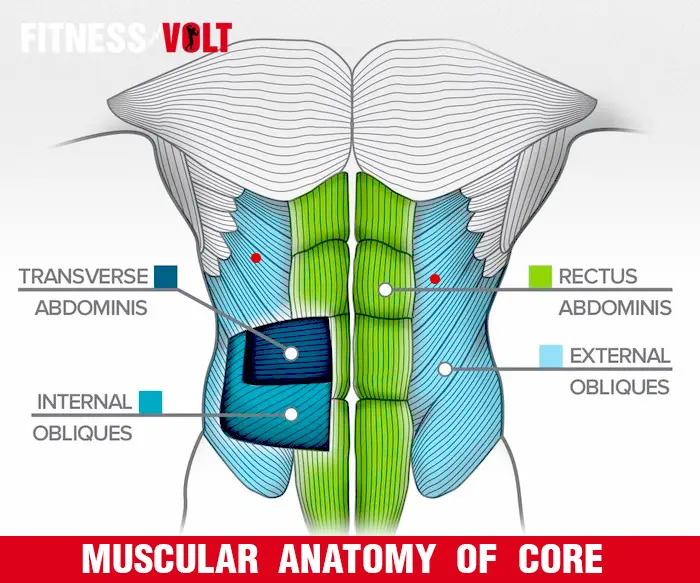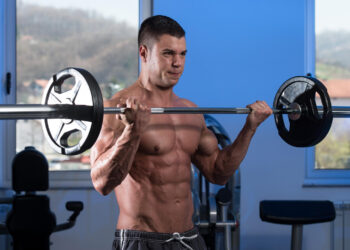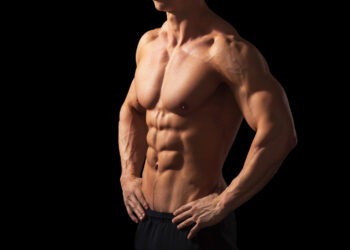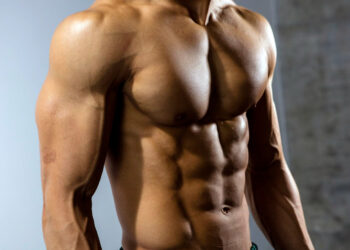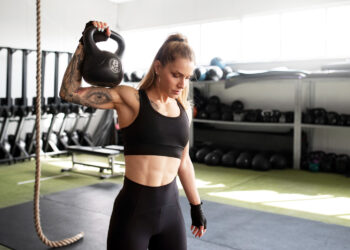When it comes to core training, most people head straight to the floor and start pumping out sit-ups, crunches, and other bodyweight exercises. While these movements can be somewhat effective, they may not be the best use of your training time or energy.
As a personal trainer with over 30 years of experience, I’ve long believed that time and energy are your most valuable commodities. As such, I hate to see them wasted on ineffective exercises and workouts.
Because of this, I rarely prescribe basic bodyweight core exercises to my clients. Instead, I use weighted movements that really challenge the midsection, fatiguing the muscles in a much shorter time. After all, you wouldn’t do sets of 30-50 reps for your biceps or hamstrings, so why treat your core any differently?
In this article, I share some of my favorite barbell exercises for building a rock-hard core. Using a barbell means you can overload your muscles without relying on things like cable machines or medicine balls. Barbells might be low-tech, but they’re high-effect and provide lots of bang for your workout buck.
The 11 Best Barbell Exercises for a Rock-Hard Core
Are you looking for the best barbell exercises for your core? Then you’ve come to the right place! Based on my extensive experience as a personal trainer, athlete, and fitness lecturer, these are my favorite barbell core exercises.
- Javelin press
- Barbell suitcase deadlift
- Barbell suitcase carry
- Barbell rollout
- Barbell serratus sit-up
- Barbell leg lifts
- Barbell windshield wipers
- Barbell full-contact twist
- Barbell plank & row
- Barbell good-morning
- Barbell overhead carry
1. Javelin press
Muscles worked: Core, deltoids, triceps.
Level Up Your Fitness: Join our 💪 strong community in Fitness Volt Newsletter. Get daily inspiration, expert-backed workouts, nutrition tips, the latest in strength sports, and the support you need to reach your goals. Subscribe for free!
The javelin press might seem like an odd thing to include on a list of core exercises, but it’s actually a great choice. You’ll need to dig deep and use your core to prevent unwanted lateral or sideways movement of your spine as you work your shoulders and arms. This is precisely how your core muscles work in nature, making this a very functional exercise.
Steps:
- Place a barbell in a squat rack set to about shoulder height.
- Stand sideways onto the bar and grip the center with your nearest hand. Brace your core.
- Unrack the bar and take a small step away from the rack. Stand with your feet shoulder-width apart and bend your knees slightly for balance and stability.
- Without leaning sideways, press the bar up and overhead to arm’s length.
- Lower it back to your shoulder and repeat.
- Rerack the bar, switch sides, and do the same number of reps with your opposite arm.
Tips:
- Grip the bar tightly to prevent it from tiling or twisting.
- Do this exercise in front of a mirror to ensure your hips and shoulders remain level.
- You can also do this exercise using a Smith machine. This makes balancing the weight a little easier but still works your core.
2. Barbell suitcase deadlift
Muscles worked: Core, quadriceps, hamstrings, gluteus maximus, forearms.
The barbell suitcase deadlift is another non-conventional core builder. However, it’s actually an excellent move for developing stronger obliques, which are the muscles in your waist. This movement teaches you how to stabilize your lumbar spine while lifting an object with one hand. As such, it has a lot of carryover to numerous everyday activities.
Steps:
- Place a loaded barbell on the floor and stand next to it. Your feet should be between shoulder and hip-width apart.
- Squat down and grip the center of the barbell. Drop your hips, lift your chest, pull your shoulder back and down, and brace your core.
- Drive your feet into the floor and stand up. Take care not to round your lower back.
- Pause for 1-2 seconds and lower the bar back to the floor.
- Let the weight settle, reset your grip and core, and repeat.
- Rest a moment, switch arms, and then do the same number of reps on the other side.
Tips:
- Use gym chalk or lifting straps to reinforce your grip if necessary.
- This exercise works best in flat-soled shoes or barefoot.
- Raise the weight on blocks to avoid starting too low and compromising your spine.
3. Barbell suitcase carry
Muscles worked: Core, quadriceps, hamstrings, gluteus maximus, forearms.
If you’ve mastered the suitcase deadlift and have the space, you’re probably ready for a new challenge: the barbell suitcase carry. As before, you must use your core muscles to stabilize your spine. However, you’ll also need to deal with the added instability caused by walking. This exercise is much more challenging, so don’t go too heavy too soon.
Steps:
- Place a loaded barbell on the floor and stand next to it. Your feet should be between shoulder and hip-width apart.
- Squat down and grip the center of the barbell. Drop your hips, lift your chest, pull your shoulder back and down, and brace your core.
- Drive your feet into the floor and stand up.
- Keeping your torso perfectly upright, go for a walk around your training area.
- Set the bar down as your core or grip starts to fail.
- Switch sides and repeat for the same duration or distance.
Tips:
- Keep your hips and shoulders level throughout.
- Grip the bar tightly to prevent tilting and twisting.
- Place your non-working hand on your waist to feel the target muscles working and reinforce your mind-muscle connection.
4. Barbell rollout
Muscles worked: Core, latissimus dorsi, pectoralis major, triceps, hip flexors.
The abs wheel rollout is a popular, effective core exercise. However, because you only use your body weight for resistance, the overload on your core is limited. Sure, you can do standing rollouts, but this is a huge step up from the kneeling variation. Barbell rollouts are modifiable to make them harder or easier. As such, they’re more adaptable than kneeling or standing abs wheel rollouts.
Steps:
- Place your loaded barbell on the floor and kneel behind it. Hold the bar with an overhand shoulder-width grip. Straighten your arms, brace your core, and pull your shoulders back and down.
- Slightly round your lower back into a posterior pelvic tilt. This engages your abs.
- Keeping your core braced, push the barbell out and away from you, lowering your torso toward the floor.
- Roll the bar back toward you until your arms are vertical.
- Continue for the desired number of reps.
Tips:
- Use collars on your bar to keep the weight plates in place.
- Reduce the weight or range of motion if you feel this exercise in your lower back.
- Keep your core engaged throughout by imagining you’re about to get punched in the gut.
5. Barbell sit-up
Muscles worked: Core, deltoids, triceps, hip flexors.
Over my 30-plus years as a personal trainer, I’ve seen the rise, fall, and rise again of sit-ups. One year, this exercise is contraindicated or dangerous; the next, it’s safe and effective.
The truth is there are very few bad exercises, but not all movements suit all bodies. So, if you can do them safely, sit-ups are a great way to strengthen your core. But, if they bother your lower back, there are plenty of exercises you can do instead. If you choose to do sit-ups, this barbell version is one of the best ways to overload your core.
Steps:
- Lie on your back with your legs bent and feet flat on the floor. Press your lower back into the floor to engage your abs.
- Hold a barbell over your chest using a shoulder-width, overhand grip. Brace your core and pull your shoulders back and down. Extend (but don’t lock) your elbows.
- Using your abs and not momentum from your arms, sit up and raise the bar above your head.
- Descending smoothly and under, lower your torso back to the floor and repeat.
Tips:
- Lie back down slower than you sit up to maximize the effectiveness of this exercise.
- Do this exercise on a mat for comfort.
- Anchor your feet if using heavy weights. However, note that doing so increases hip flexor engagement and puts more stress on your lower back.
6. Barbell leg lifts
Muscles worked: Core, deltoids, triceps, hip flexors.
Leg lifts are another of those exercises that are in one year and out the next. As with sit-ups, this challenging exercise isn’t suitable for everyone. But, if you are looking for a challenging exercise that really hammers the lower region of your abs, this exercise will appeal to you.
Steps:
- Lie on your back with your legs straight. Press your lower back into the floor to engage your abs.
- Hold a barbell over your chest using a shoulder-width, overhand grip. Brace your core and pull your shoulders back and down. Extend (but don’t lock) your elbows.
- Raise your legs until they are close to or touch the barbell. Lift your butt off the floor to maximize core engagement.
- Lower your legs, stopping a few inches above the floor, and repeat.
Tips:
- Keep your pelvis posteriorly tilted throughout to keep your core engaged and protect your lower back.
- Bend your knees to make this exercise easier.
- You can also start this exercise with both legs raised and lower each one in turn:
7. Barbell floor wipers
Muscles worked: Core, deltoids, triceps, hip flexors.
The barbell floor wiper rose to prominence as a result of the movie, “300.” Mark Twight, the trainer in charge of getting the actors in shape, used this exercise to build Spartan-level core strength and conditioning. Be warned, this is a tough exercise, but that’s what it takes to build abs like a Spartan!
Steps:
- Lie on your back with your legs straight. Press your lower back into the floor to engage your abs.
- Hold a barbell over your chest using a shoulder-width, overhand grip. Brace your core and pull your shoulders back and down. Extend (but don’t lock) your elbows. Raise your legs until they are vertical.
- Keeping your upper body stationary, rotate your hips and lower your legs down to the left and then to the right. Use slow, controlled movements.
- Continue alternating sides for the desired number of reps.
Tips:
- Keep your lower back pressed into the floor throughout.
- Bend your knees to make this exercise easier.
- Adjust your range of motion according to your mobility and flexibility.
8. Barbell full-contact twist
Muscles worked: Core, deltoids, triceps.
Contrary to what many people think, you don’t need a landmine device to do full-contact twists. In fact, my PT clients and I were doing this exercise long before landmines became popular. I love this movement for athletes, especially fighters and throwers. However, it’s beneficial for general exercisers, too
Steps:
- Put one end of your barbell against an immovable object, such as a corner of a room or the bottom of a squat or power rack.
- Hold the other end in both hands with your palms facing inward. Raise your arms above your head. Brace your core and push forward and down on the bar.
- Maintaining core tension, turn your shoulders and arms to lower the bar down to one side. Turn your hips in the same direction as your arms.
- Raise the weight back up and then repeat on the opposite side.
- Continue alternating sides for the duration of your set, pushing your arms forward and down throughout.
Tips:
- Control the momentum, and don’t let the weight control you. Raise and lower the bar smoothly and with control.
- Keep your hips still and focus more on rotating your waist to emphasize your core. However, this will reduce the amount of weight you can use.
- Use your entire body, not just your arms, to lift and lower the weight.
9. Barbell plank and row
Muscles worked: Core, deltoids, biceps, latissimus dorsi, trapezius, rhomboids.
The barbell plank and row is a uniquely challenging core exercise. It’s also very functional. In this movement, you’ll need to brace your core while lifting a weight with one arm. As such, the target muscles must work to prevent rotation of your spine and extension of your hips. This exercise will have a huge carryover to activities outside of the gym.
Steps:
- Place your barbell on the floor with one end against a wall, the bottom of a squat rack, or some other immovable object.
- Adopt the high plank position next to the end of the barbell. Brace your core.
- Hold one end with either your left or right hand. Keep your other arm straight.
- Bend your arm and row the end of the barbell up and into your side.
- Extend your arm and continue for the desired number of reps.
- Rest a moment, switch arms, and repeat.
Tips:
- This exercise is harder than it looks, so don’t go too heavy too soon.
- You can also do this exercise with a landmine device.
- Make sure you keep your hips and shoulders level – no twisting.
10. Barbell good-morning
Muscles worked: Core, gluteus maximus, hamstrings.
Barbell good-mornings are a posterior chain exercise. That means it works all the major muscles on the back of your body. That said, you can’t do good mornings without engaging your core. As such, it’s also a very effective midsection exercise and is especially effective for developing your posterior core muscles.
Steps:
- Rack and hold a barbell across your upper back. Brace your core and pull your shoulders back and down.
- Stand with your feet shoulder-to-hip width apart. Bend your knees slightly.
- Push your hips back and lean forward as far as your flexibility allows. Do not round your lower back.
- Drive your hips forward and stand back up.
- Continue for the desired number of reps.
Tips:
- Make sure the bar sits on your upper back/trapezius and not your neck.
- Place a folded towel beneath the barbell for added comfort.
- You can also do this exercise with the bar in the crooks of your elbows – the Zercher good morning.
11. Barbell overhead carry
Muscles worked: Core, deltoids, triceps.
Carrying heavy weights in almost any position will give your core a great workout. As a rule, the further the load is away from your body, the harder your core has to work to stabilize it. That means barbell overhead carries are an effective and efficient exercise for your entire midsection.
Steps:
- Clean and press your barbell overhead. Brace your core and pull your shoulders back and down. Carefully bring your feet together.
- Controlling the barbell, go for a walk around your training area. Use your core muscles to keep your torso stable and upright.
- Continue for the required duration or distance.
Tips:
- Keep your shoulders engaged throughout. This will help reduce joint stress.
- Walk sideways, in zigzags, or over low obstacles to make this exercise more challenging.
- Make sure you end your set before your arms or shoulders fail. Dropping the weight unexpectedly could cause severe injury, both to yourself and anyone nearby.
Core Anatomy Basics
You don’t need an in-depth knowledge of care anatomy to enjoy the benefits of the barbell core exercises in this article. However, knowing the basics could make it easier to choose the best movements for your needs and goals. So, to that end, here is some basic information regarding your core and the muscles that make it up.
Firstly, core is the term we use to describe the muscles that comprise your midsection. Some fitness experts include additional muscles, such as the glutes and lats, in this description.
However, I believe that just makes things more complicated than they need to be. After all, core also means middle, such as an apple core of the earth’s core. So, forget about your arms and legs and focus on the central part of your body!
Level Up Your Fitness: Join our 💪 strong community in Fitness Volt Newsletter. Get daily inspiration, expert-backed workouts, nutrition tips, the latest in strength sports, and the support you need to reach your goals. Subscribe for free!
So, with that in mind, the main muscles that make up your core are:
Rectus abdominis
Rectus abdominis is the muscle on the front of your abdomen. Its primary function is flexion of the spine, although it plays a part in lateral (sideways) flexion, too. It also helps compress your internal organs. Rectus abdominis is your “six-pack” muscle, but you need to be pretty lean to see it. Most people know the rectus abdominis as their abs.
Obliques
Located on the sides of your waist, the obliques are responsible for lateral flexion and rotation of your spine. There are two sets of oblique muscles – internal and external. Still, they mostly function together, so there is generally no need to differentiate between them.
Transverse abdominis
Known as the TVA for short, this muscle encircles your internal organs like a corset or weightlifting belt. When it contracts, it squeezes inward to create intra-abdominal pressure or IAP. IAP helps stabilize your spine and prevents unwanted movement. You activate these muscles when you brace, a common teaching point in most exercises.
Erector spinae
The erector spinae is a group of muscles running the length of the spine in two columns. They are responsible for the extension and lateral flexion of your spine. The erector spinae comprises three muscles: iliocostalis, longissimus, and spinalis. Each one affects different regions of the spine (lumbar, thoracic, cervical).
Your core muscles can generate force to result in movement, e.g., during sit-ups, or isometrically to prevent unwanted movement, e.g., during overhead carries. Both functions are important, and as such, you should include static and dynamic core exercises in your training program.
The Benefits of Barbell Core Training
So, why should core training be part of your workouts? Actually, the reasons are pretty compelling!
Reduced Risk of Back Pain
23% of the world’s adults suffer from chronic low back pain (1). Back pain is a leading cause of work absenteeism and can be incredibly debilitating. While some causes of lower back pain are unavoidable, such as automobile accidents, weak core muscles and poor posture are also contributing factors.
The core muscles help keep your spine stable, so stronger core muscles mean less stress on your lumbar vertebrae, discs, and ligaments. A strong core can help reduce your risk of back pain (2). However, exercisers with pre- or existing back pain should speak to their doctor before commencing a core strengthening program.
Improved Athletic Performance
We often say that a chain is only as strong as its weakest link. This is true in engineering, and also your body. Your core is the link that joins your upper and lower body. If your core is weak, the force generated by your arms or legs can get “lost” in your midsection.
For example, imagine you are doing deadlifts. You drive your feet into the floor to stand up, but instead of lifting the weight off the floor, your spine collapses. The force generated by your lower body won’t reach the barbell in your hands. At best, this will result in a failed lift but could also lead to injury.
A strong core has the potential to enhance all forms of athletic endeavor, from weightlifting to running to kicking to punching to throwing (3). As such, athletes from all sports engage in core training.
A Better-Looking Midsection
Form follows function, and strong muscles generally look better than weak muscles. This is as true for your core as it is for your chest, back, arms, or legs. That’s not to say the exercises in this article will give you a six-pack. That’s because six-pack abs are as much the result of your diet as they are your training.
However, get your body fat percentage low enough, and core training will improve the condition of your midsection muscles so that they aren’t just strong but look good, too.
How to Program Your Barbell Core Exercises and Workouts
While the exercises in this article will help you develop core strength, you’ll get better results if you program them logically and progressively. Here are some guidelines for getting the most from these barbell core exercises.
1. Work your core 2-3 times per week
You’ll get better results from your core training if you do it 2-3 times a week on non-consecutive days, e.g., Monday and Thursday. This provides the ideal balance between work and rest. However, don’t be tempted to train your core every day, as this will probably just lead to overtraining and even injury.
You can do your core work toward the end of your regular training session or dedicate a couple of weekly workouts to your midsection, e.g., after cardio.
2. Vary your exercises
While having a few favorite core exercises is fine, it would be a mistake to do them all the time. You’ll get better results if you vary your core workouts every 4-8 weeks. Such variation reduces the risk of burnout, boredom, and training plateaus. However, avoid changing your workouts too often, as consistency is critical for optimal progress.
3. Train your core from multiple angles
Some people go a little abs-crazy when they train their core. By that, I mean they focus too much on the rectus abdominis. Consequently, they ignore the other equally important muscles and functions of the midsection. So, to develop all-around core strength, make sure you include static and dynamic exercises for all the muscles that make up this region.
4. Vary your loads and reps
You can develop your core using low reps and heavy weights, high reps and light weights, and moderate reps with medium weights. However, rather than just pick one loading parameter, you should use them all to develop core strength and endurance equally.
For example, your next barbell core workout could look something like this:
- Suitcase deadlifts – 3 sets 6 reps per side (heavy)
- Rollouts – 3 sets of 12 reps (moderate)
- Full-contact twists – 3 sets of 20 reps (light)
Such an approach will ensure you train all muscular fitness components equally, creating a core that’s both strong and enduring.
5. Leave a couple of reps “in the tank”
While you should train your core hard, you should avoid going to failure. If your core muscles fail, you run the risk of destabilizing your spine, causing severe injury. This is especially true for the barbell exercises outlined in this article.
So, be a little more conservative and end your set before your core is completely exhausted. This will make your workouts as safe as possible. If you do want to push your core to failure, do it with low-risk bodyweight exercises.
6. Always use good form
There are two ways to do any exercise – the right way and the wrong way. The right way is safe and effective and keeps the stress on your muscles and off your ligaments and joints. The wrong way is typically less productive and more likely to cause injury. With core exercises, those injuries can be severe, as it’s your lumbar spine that bears the load.
Subsequently, make sure you study the instructions and videos provided to ensure you do each exercise correctly. Get expert advice from a qualified trainer if you are still unsure. Finally, never sacrifice the correct form for more weight or reps. The risks outweigh the benefits.
Closing Thoughts
Core training should be the cornerstone of most exerciser’s workouts. A strong core enhances athletic performance, protects you from injury, and can help you develop the midsection of your dreams.
While bodyweight core exercises can be effective, the low loads mean you’ll probably need to perform high reps to fatigue your muscles. This is neither time-efficient nor effective for building strength.
Barbell core exercises let you hit work your muscles against a more significant load, making your training more productive. Plus, personally speaking, these exercises are much more satisfying and fun than the same old sit-ups and crunches!
So, try these exercises for yourself. My clients and I love them, and I think you will, too.
References:
- Casiano VE, Sarwan G, Dydyk AM, et al. Back Pain. [Updated 2023 Feb 20]. In: StatPearls [Internet]. Treasure Island (FL): StatPearls Publishing; 2023 Jan-.
- Baerga-Varela L, Abréu Ramos AM. Core strengthening exercises for low back pain. Bol Asoc Med P R. 2006 Jan-Mar;98(1):56-61. PMID: 19610550.
- Dong K, Yu T, Chun B. Effects of Core Training on Sport-Specific Performance of Athletes: A Meta-Analysis of Randomized Controlled Trials. Behav Sci (Basel). 2023 Feb 9;13(2):148. doi: 10.3390/bs13020148. PMID: 36829378; PMCID: PMC9952339.

